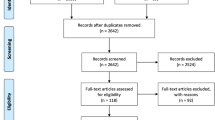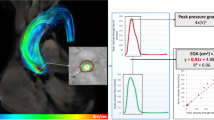Abstract
Aim
To prospectively evaluate the accuracy of cardiac magnetic resonance (cMR) imaging for the assessment of aortic valve effective orifice area (EOA) by continuity equation and anatomical aortic valve area (AVA) by direct planimetry, as compared with transthoracic (TTE) and transesophageal (TEE) two-dimensional (2D) echocardiography, respectively.
Methods and results
A total of 31 patients (21 men, 10 women, mean age 69 ± 10 years) with moderate-to-severe aortic stenosis (AS) diagnosed by TTE and scheduled for elective aortic valve replacement, underwent both cMR and TEE. AVA by cMR was obtained from balanced steady-state free-precession cine-images. EOA was computed from phase-contrast MR flow analysis. AVA at cMR (0.93 ± 0.42 cm2) was highly correlated with TEE-derived planimetry (0.92 ± 0.32 cm2) (concordance correlation coefficient, CCC = 0.85). By excluding 11 patients with extensively thickened and heavily calcified cusps, the CCC increased to 0.93. EOA at cMR (0.86 ± 0.30 cm2) showed a strong correlation with TTE-derived EOA (0.78 ± 0.25 cm2) (CCC = 0.82).
Conclusions
cMR imaging is an accurate alternative for the grading of AS severity. Its use may be recommended especially in patients with poor transthoracic acoustic windows and/or in case of discordance between 2D echocardiographic parameters.




Similar content being viewed by others
Abbreviations
- AVA:
-
Aortic valve area
- AS:
-
Aortic valve stenosis
- EOA:
-
Effective orifice area
- CMR:
-
Cardiac magnetic resonance
- TTE:
-
Transthoracic echocardiography
- TEE:
-
Transesophageal echocardiography
- CT:
-
Computed tomography
- bSSFP:
-
Balanced steady-state free precession
- PC:
-
Phase-contrast
- VENC:
-
Encoding velocity
- CCC:
-
Concordance correlation coefficient
- LVEF:
-
Left ventricular ejection fraction
- LVOT:
-
Left ventricular outflow tract
- LVOTCSA :
-
Left ventricular outflow tract cross-sectional area
- VTI:
-
Velocity time integral
- V:
-
Peak jet velocity
- VAO:
-
Peak aortic jet velocity
- VLVOT:
-
Peak left ventricular outflow tract jet velocity
- SV:
-
Stroke volume
References
Selzer A (1987) Changing aspects of the natural history of valvular aortic stenosis. N Engl J Med 317:91–98
Otto CM, Kuusisto J, Reichenbach DD, Gown AM, O’Brien KD (1994) Characterization of the early lesion of ‘degenerative’ valvular aortic stenosis. Histological and immunohistochemical studies. Circulation 90:844–853
Lindroos M, Kupari M, Heikkila J, Tilvis R (1993) Prevalence of aortic valve abnormalities in the elderly: an echocardiographic study of a random population sample. J Am Coll Cardiol 21:1220–1225
Vahanian A, Alfieri O, Andreotti F et al (2012) Guidelines on the management of valvular heart disease (version 2012). Eur Heart J 33:2451–2496
Nishimura RA, Otto CM, Bonow RO et al (2014) 2014 AHA/ACC guideline for the management of patients with valvular heart disease: a report of the American College of Cardiology/American Heart Association Task Force on Practice Guidelines. J Am Coll Cardiol 63:e57–e185
Cannon SR, Richards KL, Crawford MH et al (1988) Inadequacy of the Gorlin formula for predicting prosthetic valve area. Am J Cardiol 62:113–116
Yoon YE, Hong YJ, Kim HK et al (2014) 2014 Korean guidelines for appropriate utilization of cardiovascular magnetic resonance imaging: a joint report of the Korean Society of Cardiology and the Korean Society of Radiology. Korean J Radiol 15:659–688
Sondergaard L, Hildebrandt P, Lindvig K et al (1993) Valve area and cardiac output in aortic stenosis: quantification by magnetic resonance velocity mapping. Am Heart J 126:1156–1164
Cawley PJ, Maki JH, Otto CM (2009) Cardiovascular magnetic resonance imaging for valvular heart disease: technique and validation. Circulation 119:468–478
Kramer CM, Barkhausen J, Flamm SD, Kim RJ, Nagel E (2013) Society for Cardiovascular Magnetic Resonance Board of Trustees Task Force on Standardized P. Standardized cardiovascular magnetic resonance (CMR) protocols 2013 update. J Cardiovasc Magn Reson 15:91
Picard MH, Adams D, Bierig SM et al (2011) American Society of Echocardiography recommendations for quality echocardiography laboratory operations. J Am Soc Echocardiogr 24:1–10
Caruthers SD, Lin SJ, Brown P et al (2003) Practical value of cardiac magnetic resonance imaging for clinical quantification of aortic valve stenosis: comparison with echocardiography. Circulation 108:2236–2243
Waters EA, Caruthers SD, Wickline SA (2005) Correlation analysis of stenotic aortic valve flow patterns using phase contrast MRI. Ann Biomed Eng 33:878–887
Myerson SG (2012) Heart valve disease: investigation by cardiovascular magnetic resonance. J Cardiovasc Magn Reson 14:7
Muzzarelli S, Monney P, O’Brien K et al (2014) Quantification of aortic flow by phase-contrast magnetic resonance in patients with bicuspid aortic valve. Eur Heart J Cardiovasc Imaging 15:77–84
Yap SC, van Geuns RJ, Meijboom FJ et al (2007) A simplified continuity equation approach to the quantification of stenotic bicuspid aortic valves using velocity-encoded cardiovascular magnetic resonance. J Cardiovasc Magn Reson 9:899–906
Lin LI (1989) A concordance correlation coefficient to evaluate reproducibility. Biometrics 45:255–268
Stoddard MF, Arce J, Liddell NE, Peters G, Dillon S, Kupersmith J (1991) Two-dimensional transesophageal echocardiographic determination of aortic valve area in adults with aortic stenosis. Am Heart J 122:1415–1422
Tribouilloy C, Shen WF, Peltier M, Mirode A, Rey JL, Lesbre JP (1994) Quantitation of aortic valve area in aortic stenosis with multiplane transesophageal echocardiography: comparison with monoplane transesophageal approach. Am Heart J 128:526–532
Friedrich MG, Schulz-Menger J, Poetsch T, Pilz B, Uhlich F, Dietz R (2002) Quantification of valvular aortic stenosis by magnetic resonance imaging. Am Heart J 144:329–334
John AS, Dill T, Brandt RR et al (2003) Magnetic resonance to assess the aortic valve area in aortic stenosis: how does it compare to current diagnostic standards? J Am Coll Cardiol 42:519–526
Kupfahl C, Honold M, Meinhardt G et al (2004) Evaluation of aortic stenosis by cardiovascular magnetic resonance imaging: comparison with established routine clinical techniques. Heart 90:893–901
Debl K, Djavidani B, Seitz J et al (2005) Planimetry of aortic valve area in aortic stenosis by magnetic resonance imaging. Invest Radiol 40:631–636
Hildebrand LB, Buonocore MH (2002) Fully refocused gradient recalled echo (FRGRE): factors affecting flow and motion sensitivity in cardiac MRI. J Cardiovasc Magn Reson 4:211–222
von Knobelsdorff-Brenkenhoff F, Rudolph A, Wassmuth R et al (2009) Feasibility of cardiovascular magnetic resonance to assess the orifice area of aortic bioprostheses. Circ Cardiovasc Imaging 2:397–404 (2 p following 404)
Pouleur AC, le Polain de Waroux JB, Pasquet A, Vancraeynest D, Vanoverschelde JL, Gerber BL (2007) Planimetric and continuity equation assessment of aortic valve area: head to head comparison between cardiac magnetic resonance and echocardiography. J Magn Reson Imaging 26:1436–1443
Paelinck BP, Van Herck PL, Rodrigus I et al (2011) Comparison of magnetic resonance imaging of aortic valve stenosis and aortic root to multimodality imaging for selection of transcatheter aortic valve implantation candidates. Am J Cardiol 108:92–98
Janosi RA, Plicht B, Kahlert P et al (2014) Quantitative analysis of aortic valve stenosis and aortic root dimensions by three-dimensional echocardiography in patients scheduled for transcutaneous aortic valve implantation. Curr Cardiovasc Imaging Rep 7:9296
Chin CW, Khaw HJ, Luo E et al (2014) Echocardiography underestimates stroke volume and aortic valve area: implications for patients with small-area low-gradient aortic stenosis. Can J Cardiol 30:1064–1072
Koos R, Mahnken AH, Kuhl HP et al (2006) Quantification of aortic valve calcification using multislice spiral computed tomography: comparison with atomic absorption spectroscopy. Invest Radiol 41:485–489
La Grutta L, Toia P, Galia M et al (2016) Role of cardiac computed tomography in the evaluation of coronary artery stenosis in patients with ascending aorta aneurysm detected at transthoracic echocardiography. J Comput Assist Tomogr 40:393–397
Pouleur AC, le Polain de Waroux JB, Pasquet A, Vanoverschelde JL, Gerber BL (2007) Aortic valve area assessment: multidetector CT compared with cine MR imaging and transthoracic and transesophageal echocardiography. Radiology 244:745–754
Furukawa A, Abe Y, Tanaka C et al (2012) Comparison of two-dimensional and real-time three-dimensional transesophageal echocardiography in the assessment of aortic valve area. J Cardiol 59:337–343
Garcia J, Kadem L, Larose E, Clavel MA, Pibarot P (2011) Comparison between cardiovascular magnetic resonance and transthoracic Doppler echocardiography for the estimation of effective orifice area in aortic stenosis. J Cardiovasc Magn Reson 13:25
Acknowledgements
No funding sources to be acknowledged from the Italian team. The part of this work performed in the UK was partially supported by the NIHR Bristol Cardiovascular Biomedical Research Unit (to Dr Chiara Bucciarelli-Ducci). The content of this work represents the opinion of the authors and not of the UK Department of Health.
Author information
Authors and Affiliations
Corresponding author
Ethics declarations
Conflict of interest
No conflicts of interest as to the content of this manuscript are reported by any of the authors.
Ethical approval
All procedures performed in studies here presented and involving human participants were in accordance with the ethical standards of the national research committee and with the 1964 Declaration of Helsinki and its later amendments or comparable ethical standards. Not applicable: retrospective analysis of data acquired for clinical purpose: as such, approval from the local Ethics Committee was not necessary and was not sought.
Informed consent
Informed consent for the performance of the diagnostic examinations here reported was obtained from all individual participants included in the study.
Electronic supplementary material
Below is the link to the electronic supplementary material.
Rights and permissions
About this article
Cite this article
Mantini, C., Di Giammarco, G., Pizzicannella, J. et al. Grading of aortic stenosis severity: a head-to-head comparison between cardiac magnetic resonance imaging and echocardiography. Radiol med 123, 643–654 (2018). https://doi.org/10.1007/s11547-018-0895-2
Received:
Accepted:
Published:
Issue Date:
DOI: https://doi.org/10.1007/s11547-018-0895-2




